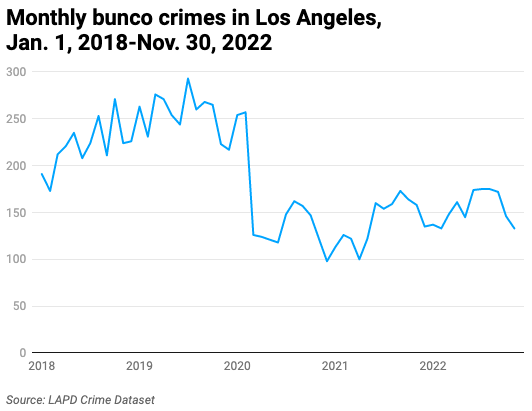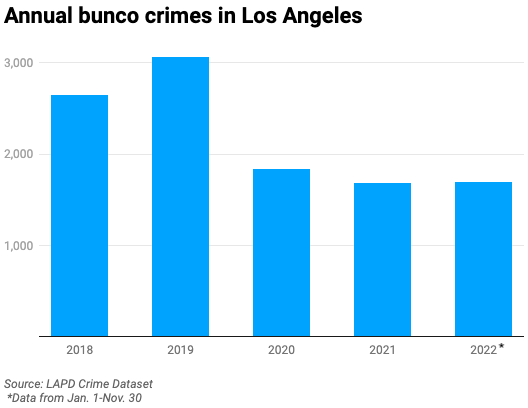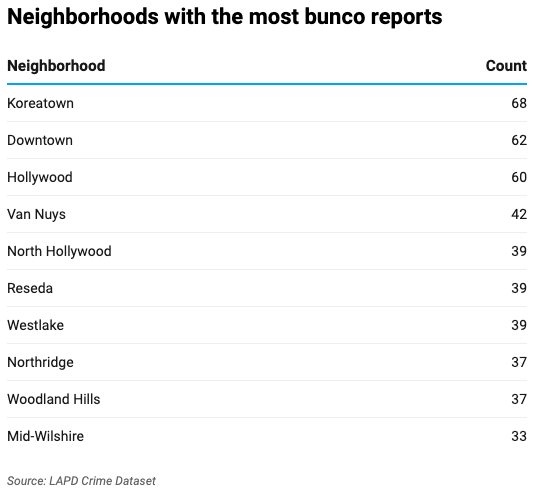Street scams are way down in the post-COVID era

In the year before the pandemic, about 250 Angelenos each month were falling victim to street scams, con games or other “bunco” crimes. The incidents included everything from fake gold jewelry sales to someone knocking on the door of a home and persuading the resident to hand over cash for a repair that would never be made.
Not surprisingly, reports tumbled with people unwilling to come face to face with strangers. But although many Angelenos are back to their pre-COVID life, bunco incidents occur far less frequently than they did before the coronavirus.
According to publicly available Los Angeles Police Department data, the highest monthly count since February 2020 was the 175 bunco reports recorded in both July and August of 2022. In November, there were 138 incidents.

This is a major reversal. From 2010–2019, bunco crimes increased every year, rising to 3,065 reports.
Through Nov. 30, 2022, the LAPD fielded 1,707 reports of bunco crime. Although that is a 0.7% increase from the number of incidents reported in all of 2021, it is a 44.6% decrease from 2019.

Using trickery
Bunco crimes occur when trickery is used to persuade a victim to give up money or property. LAPD reports commonly refer to these as con games or swindles.
In a typical bunco scenario, a criminal gains the victim’s confidence by telling a believable story, which is followed by a request for help, money or goods. Many scammers convince a victim to pay upfront for the promised item or service.
According to police data, bunco crimes most commonly occur not on the street, but rather at the victim’s residence. From Jan. 1–Nov. 30, 821 bunco crimes were reported at single-family homes, more than any other location. Another 377 bunco schemes occurred at multi-unit dwellings.
The numbers could easily be much higher, as the data is assembled from people who report a crime to the LAPD. Some victims may be embarrassed about falling prey to a scam. Others may not trust police, or believe a suspect will never be found.
Pete Robinson, executive director of the National Association of Bunco Investigators, noted that even though numbers increased in the COVID era, the scams did not disappear, and thieves adapted.
“When the country shut down, there were more stay-at-homes and people working from home, which provided a target-rich environment for phone scams,” said Robinson. He added, “There was an increase in other types of cons and scams.”
Through Nov. 30, Koreatown was the most frequent Los Angeles neighborhood for bunco reports, with 68 incidents. Close behind was Downtown, where there were 62 reports.

Who the scammers scam
Scam artists notoriously target senior citizens, especially during the holiday season. A report conducted by the FBI’s Internet Crimes Complaint Center found that the older the victim, the more money they lost from fraud.
In 2021, more than 92,000 Americans over the age of 60 reported losing nearly $1.7 billion to fraud, according to the FBI report.
Bunco crimes are not limited to the elderly. Last year, adults under 60 were more likely to fall for fraud scams and lose more money than those over 60, according to the Federal Trade Commission. These individuals were four times more likely to lose money in fake cryptocurrency schemes, and five times more likely to lose money from job scams.
Robinson’s organization seeks to counter fraud and scams through publicly available information and awareness. The NABI also recommends that people grab packages right when they arrive, only purchase gift cards directly from a retailer or its website, and make sure donations are going to real charities.
They also suggest always paying by credit card or check, which can provide a level of protection if a scam surfaces.
While bunco crimes have fallen in the city of Los Angeles, these incidents have increased on a national level, according to the FBI’s Internet Crimes Complaint Center and the FTC.
How we did it: We examined publicly available LAPD data on bunco crimes from Jan. 1, 2010–Nov. 30, 2022. For neighborhood boundaries, we rely on the borders defined by the Los Angeles Times. Learn more about our data here.
LAPD data only reflects crimes that are reported to the department, not how many crimes actually occurred. In Making our calculations, we rely on the data the LAPD makes publicly available. LAPD may update past crime reports with new information or recategorize past reports. Those revised reports do not always automatically become part of the public database.
Want to know how your neighborhood fares? Or simply just interested in our data. Email us at askus@xtown.la.






